The Nissan Rogue is one of the best-selling compact crossovers on the market. It’s also sold – for less – by Mitsubishi.
With more.
The Outlander – which shares a platform and mechanicals with the Rogue – seats seven in three rows vs. five in two.
It also has a smaller price tag – and a bigger warranty.
Besides which, you might just like its looks better!
The Outlander is Mitsubishi’s take on the Nissan Rogue, which serves as the starting point for this compact crossover. It is one of very few crossovers its size that offers seating for seven – and the only one you can get at this price.
The base ES – which has three rows, standard – stickers for $25,795 with front-wheel-drive; with the optional AWD system, the MSRP is $27,595.
For cross-shopping purposes, the Kia Sorento – which is about the same size and also offers a third row – stickers for $29,490 to start, with FWD. With the optional AWD system, the Kia lists for $31,790.
A Nissan Rogue – which does not offer third row seating – stickers for $26,050 to start.
It also comes with a five-year/60,000 mile whole-thing warranty. The same thing with a Mitsubishi skin comes with a three-year/36,000 mile warranty. And what’s under this Mitsubishi’s hood is covered for ten years or 100,000 miles – even though it’s the same thing that Nissan only covers for five years and 60,000 miles.
A top-of the line Outlander SEL Launch Edition with AWD, panorama sunroof, 10 speaker audio system, three zone climate control and a 12.3 inch driver-configurable digital display instrument cluster stickers for $35,345.
What’s New
The 2022 Outlander is all new. It is based on the new-last-year (this calendar year) Nissan Rogue but has its own look as well as a different ensemble of standard and optional equipment.
What’s Good
The least expensive three-row crossover on the market.
A better deal – with a much better warranty – than the same thing (mechanically) sold under the Nissan label.
Tows more than its Nissan-badged sibling.
What’s Not So Good
Third row is a tight squeeze for people – and squeezes out cargo room, which the Outlander has less of with its seats in place than the Rogue’s got.
Like the Rogue, there’s only one engine – and one transmission – regardless of trim.
The mechanically identical Rogue advertises significantly higher gas mileage: 27 city, 35 highway for the FWD version vs. 24 city, 31 highway for the same thing under Mitsubishi skin.
Regardless of trim, every Outlander comes standard with the same 2.5 liter, 181 horsepower four cylinder engine, paired up with the same continuously variably (CVT) automatic transmission.
It’s a larger engine the typical turbocharged 2.0 liter (or smaller) engines that are becoming common in medium-small crossovers – which need a turbo to make up for being smaller. This engine has high (12.0:1) compression, instead – which basically does the same thing (increases cylinder pressure, to make more power) but without the extra parts – and extra expense.
This could save you money down the road, since you will never have to worry about replacing the turbo (or intercooler) this crossover doesn’t come with.
It is also the same Nissan-built engine used in the Nissan-bodied Rogue – but for some reason the Mitsu-bodied version is rated as delivering only 24 MPG in city driving and 31 on the highway vs. the Rogue’s 27 city, 35 highway.
Actually, there is a reason – though it has nothing to do with the engine (or the transmission).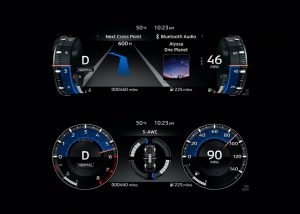
The Mitsu-bodied iteration of this crossover is 222 pounds heavier than the Nissan-bodied version (3,593 lbs. vs. 3,371 lbs.) probably because of the extra row as well as the extra couple inches of length. Also, the Mitsu’s more stylistically interesting bodywork is blockier and so probably slightly less aerodynamic.
There is a compensatory factor – although it applies to both iterations of this crossover: The non-turbo’d engine under both of their hoods doesn’t need premium fuel to deliver its rated horsepower – as is the case with some of the tiny turbo’d engines out there. That saves you about 30 cents per gallon at each fill-up, which is kind of like getting an extra 2-3 MPG out of each gallon of gas.
There’s another interesting difference between these mechanically identical crossovers: The Mitsu-bodied version is rated to tow up to 2,000 lbs. while the same thing wearing Nissan panels carries a much lower 1,350 lb. maximum tow rating. Whether the Nissan can handle up to 2,000 lbs. isn’t the point – unless you don’t care about the coverage.
If you tow more than what the company that made your vehicle (and issued the warranty) says it can tow – and something breaks – you’ll be paying to fix it, not them.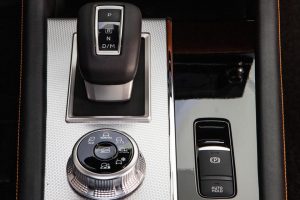
Speaking of what’s covered…
Mitsubishi backs Nissan’s engine/transmission for ten years/100,000 miles – whereas the same engine/transmission under the hood of the Nissan iteration of this crossover is only warranted for five years and 60,000 miles.
It may only be a marketing difference – if something doesn’t break.
But if it does . . .
And if it does, any Nissan store can fix it – or get parts. Some worry about buying a Mitsu because Mitsubishi has a much smaller presence than Nissan – which has stores in every town.
That’s not an issue here – because the Outlander is a Nissan, mechanically-speaking. Same parts – same service.
You do have one choice – in both cases – as regards the drivetrain: It’s offered with either front-wheel-drive (standard in most trims) or all-wheel-drive, which is optional in all trims except the top-of-the-line SEL Launch Edition, which comes with it standard.
The Outlander feels bigger than it is – as Mitsubishi intended.
Though the underthings are largely the same, there are some important differences to which this can be attributed. Both the Mitsu-bodied and the Nissan-bodied versions ride on the same 106.5 inch wheelbase but the Outlander is wider than the Rogue by more than two inches (74.7 inches vs. 72.4 inches) and this sense of broad-shoulder’d-ness is accentuated by the Mitsu’s flat – and wide – hood vs. the Rogue’s more round-shoulder’d stamping.
The downside is that it’s sometimes hard to see over that flight-deck slab of a hood, particularly when negotiating a tight turn on an incline on a narrow gravel road. But – as is true with any vehicle – you develop a sense of where things are (and end) as you get used to driving the thing.
Once that is done, you may enjoy the beefy feel of this thing.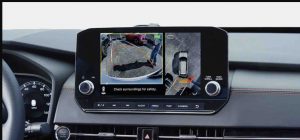
Power delivery gives a deceptive sense of the power that’s available – a thing both good and bad. What I mean by this is that the 2.5 liter engine hasn’t got a lot of power to spare but it feels much stronger than it is – at first – due to very deep (5.694) final gearing. If it weren’t for the CVT automatic’s ability to cut the effective gearing by half or more once you’re rolling, this thing would probably have a top speed around 80 MPH, like a muscle car rear-geared for the eighth mile – without an overdrive gear in its transmission.
Because it has all that leverage down low, it practically lunges forward from a dead stop. You could be persuaded it has a 3.5 liter V6 under the hood.
But once it gets going – and the leverage advantage isn’t there – the modest amount of power on tap becomes apparent. It’s enough – just not plenty. It takes about 8.2 seconds to get to 60.
This is isn’t slow; it’s only about half a second behind what’s typical in the class.
 But there are times when you may wish there was more power available, as when wanting to get around a Prion-addled driver doing 42 in a 55 but with oncoming traffic in the passing lane closing the gap quickly.
But there are times when you may wish there was more power available, as when wanting to get around a Prion-addled driver doing 42 in a 55 but with oncoming traffic in the passing lane closing the gap quickly.
Excepting that, it cuts the mustard. The fact is that if you’re on the ball, you can almost always pass when you need to. Your timing decreases the amount of time needed – no matter what’s you’re driving.
Mitsubishi-Nissan does a really good job programming the CVT automatic to not behave (or sound) like one. It mimics shifts, even though it doesn’t (CVTs vary ranges) and – unlike some CVTs – this one will “shift” to a lower range as you accelerate rather than hold itself (and the engine) in a higher range, until you back off the accelerator.
The handling is good enough that this Mitsu-altered Nissan’s ability to cut apexes is limited by its tires, which squeal and slip long before the body rolls.
And like most crossovers – which have four wheel independent suspensions that can articulate each individual wheel with off-road irregularities – the Outlander doesn’t force you to crawl up washboard gravel roads to avoid knocking your fillings loose from the reverb.
It’s the looks – as much as the warranty (and extra seats) that sell this thing – vs. the other thing.
If you didn’t know, it’d be hard to tell.
That goes for the inside as well as the outside. Especially if you choose the optionally available Tech package, which transforms this Mitsubishi into what looks a lot like the latest Land Rover. You sit before a digital instrument panel with a pair of offset scrolling wheels that display engine RPM and road speed. Engine turned facings, diamond-stitched/pleated leather-looking door panel inserts
Even the shifter looks familiar.
So also the O U T L A N D E R block letter decals on the front of the hood, spaced very much like the block letter decals on another – much more pricey – ride.
But the main difference – or rather, sell – is the Outlander’s extra row. It’s a shame it’s not a rear-facing row, which would give it the legroom that’s lacking as well as make access easy rather than difficult. This is a problem with almost all third rows, excepting those in super-sized crossovers (and SUVs) and – of course – minivans, which have those huge-opening dual sliding doors.
A rear-facing third row would also be a fun place to sit – especially for the kids these seats are generally meant for. Watching the world recede as the vehicle rolls is a lot more entertaining (and a lot more real) than watching another video on the DVD player.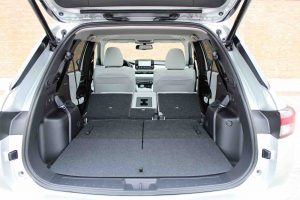
But the government – via its endless regulations – has made offering a rear-facing third row a non-starter, regardless of that orientation’s superior functionality. Speaking of which . . .
The cost of that extra row is less cargo room behind that row, which is only 11.7 cubic feet in the Mitsu vs. 31.6 in the two-row Nissan. This former is less cargo room than is typically found in most current compact-sized cars. The latter is about twice as much as you’ll find under the trunk lid of most current mid-sized cars.
However, if you fold the Mitsu’s second and third row, you end up with a little more total cargo room – 79.7 cubic feet vs. 74.1 in the Nissan.
The Rest
All trims – including the base $25,795 ES – come standard with 18 inch wheels, LED headlights, dual zone climate control and a six speaker audio system. The more expensive Rogue comes standard with 17 inch wheels, manual AC and a four speaker stereo. If you want the amenities that come standard with the Mitsu in the Nissan, you have to step up to the SV trim – which costs even more ($27,470) than the as-it-comes Outlander.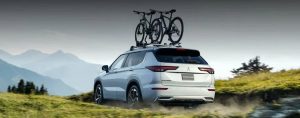
You can also get 20 inch wheels with the base trim ES – without having to step up to the more pricey SE and SEL trims, first.
The Bottom Line
Sometimes the same thing is better when it’s wrapped differently.
. . . .
Got a question about cars, Libertarian politics – or anything else? Click on the “ask Eric” link and send ’em in! Or email me at [email protected] if the @!** “ask Eric” button doesn’t work!
If you like what you’ve found here please consider supporting EPautos.
We depend on you to keep the wheels turning!
Our donate button is here.
If you prefer not to use PayPal, our mailing address is:
EPautos
721 Hummingbird Lane SE
Copper Hill, VA 24079
PS: Get an EPautos magnet or sticker or coaster in return for a $20 or more one-time donation or a $10 or more monthly recurring donation. (Please be sure to tell us you want a magnet or sticker or coaster – and also, provide an address, so we know where to mail the thing!)
My eBook about car buying (new and used) is also available for your favorite price – free! Click here. If that fails, email me at [email protected] and I will send you a copy directly!




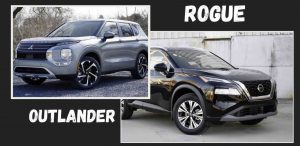
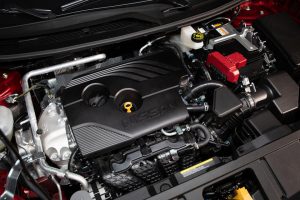
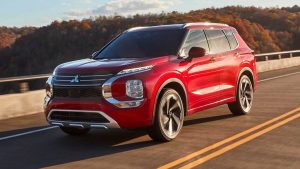








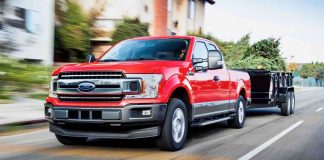
Had no idea that this was a Nissan. At least they didn’t cheap out and did different sheet metal.
I really like it… it is too bad about Mitsu leaving Europe. I thought they had made a lot of headway with the outlander phev (I like that one too; Good replacement for my aging Volt). Seems like they’re giving up a lot of name recognition/brand loyalty.
Hi Anon,
I agree – Mitsu makes the most sensible small economy car you can still buy (the Mirage) which is a car very few people seem to know exists. And that’s the problem, for Mitsu. They are invisible to many, who never even think about buying one before they buy another car.
I have been calling Mitsubishi “Mistake” for decades. And the legacy carries on. Amazing.
Not sure if you’ve heard – but Mitsubishi is leaving the European market…. a bit of a surprise because the outlander PHEV was actually the first Plug in hybrid here that made a real impact… was actually really practical, cheap (compared to others at least) and very very tax efficient, even qualifying for parking in central London in an electric car spot (which back then were not only free – but also always available!) . I drove this some years back and even found it handled pretty well for its size…. (they told me it used a lot of the same traction control and torque vectoring they had on the Evo a decade or so earlier). I just didnt get it because I just liked the drive of a manual BMW better, though one can argue this car would have been the more cost effective solution.
Any idea / thoughts on why they ‘re leaving ? The official notice says to “focus on home markets”…. i have a feeling theres more to it….
Hi Nasir,
Mitsu is a very small player and that probably accounts for it. I’m surprised they are still hanging on, here. But they are still pretty solid in Asia. I hope they persevere. I like the little Mirage a lot. It’s inexpensive and efficient – which is hard to find, these days.
CVT makes it a no-go for me, but I have to say that the front badge styling reminds me more of a Kia TELLURIDE than the BENDOVER.
Hi Kevin,
I think they both (Kia and Mitsu) found inspiration in the same place! I dislike CVTs as well. If this thing had a V6/six-speed and rear-facing third row seats, it’d be a very appealing rig.
I found the newer Cvt gearboxes are pretty good in rentals. I really enjoyed my mirage rental. they whip around town but low power is more of an issue on the highway. I really like how the mirage doesnt pretend to have set gears. But for a daily driver, id prefer a high compression L6 and a manual gearbox.
The diff in this thing is interesting, so they are using cvt’s so they can use really aggressive diffs (higher numerical), so they can use tiny engines, for fuel economy but they can get through an intersection at a normal pace.
The new Corvette has no manual trans, probably because it would make it too slow plus have a lower top speed. The double clutch trans it uses has 8 gears so it can have an aggressive 4:90 diff, making it quick and have a high top speed with 3 overdrive gears. A manual trans is limited to 6 gears usually, so it needs a longer diff (numerically lower), this makes it slower and have a lower top speed. This is where manual trans are limited. A lot of manual trans cars were ruined by putting longer gears in them for fuel economy etc. one example is the Porsche Cayman GT4, another the mk3 GTI. The mk3 GTI 2 litre dominated ITB racing, they made it quick with really short gears, 5:11 diff. the new Miata doesn’t have that problem, they had to use short gears or it would be slow.
Larry
The first part of your comment…yecch. I died a little inside. That’s a recipe for blowing out the engine or the diff sooner rather than later, maybe it will last if you baby it. You can get by with a high diff ratio, but only if you beef up the parts and put some power behind it…
Hi Larry,
Yup.
I have an old (1976) Pontiac Trans-Am, which as you know was not available with overdrive when it was made. Thus, the most aggressive final drive (axle ratio) you could go with for best (quickest) 0-60 and 1/4 mile runs – and still have a car you could realistically drive on the street – was around 3.23 or so. Even then, the car’s engine was spinning around 3,000 RPM at 60-70 and at 80 it would be screaming at 3,500-plus (redline around 5,400).
I put an OD tranny in my car that has a .67 overdrive ratio, which enables me to run 3.90 rear axle gears and have a cruise RPM at 70 of just over 2,000 RPM!
Check out the 2023 Corvette. It has the flat plane crank V8 so it revs to 8600 rpm, because of this they can now use a 5:56 diff and do 0 to 60 in 2.6 secs and with 3 overdrives gears it will still do 200 mph. With a 6 speed standard it would be slower or have a very low top speed, now you know why there is no stick shift. That transaxle would be a great performance upgrade for an older car. It is all electronic so it would be a nightmare swapping it into something interesting like a mid engine kit car. Kit cars that is an interesting world, cheaper cars, usually lighter, Jay Leno says the best cars are the homemade ones, watch these bastards outlaw them.
The diff in this thing is interesting, so they are using cvt’s so they can use really aggressive diffs (higher numerical), so they can use tiny engines, for fuel economy but they are responsive enough that they can can get through an intersection at a normal pace.
I don’t like this junk, yes they probably will self destruct with low mileage and cost a fortune to fix and end up causing the car to be scrapped, what a joke. The government ruined all the cars with their regulations, they all weigh 3000 lb minimum and are all plastic and computers.
If you like driving get a super 7, a Caterham or one of the many super 7 clones, they are the way a car should be, mechanical art made to go fast, no other function, fun only. They are the perfect platform to build what you like. They have a tube frame that weighs 100 lb, their total weight is around 540 kg, 1200 lb. (that is the key right there very light weight), fiberglass or aluminum body, use whatever suspension, brakes and steering you like, now you can use any drivetrain you like, a Caterham 620s has a 310 hp supercharged Ford 4 cyl, 0 to 60 in 2.9 seconds. The German HKT has a 400 hp Audi 1.8 20vt 4 cyl, 0 to 125 mph in 7.7 secs., $80,000, quicker then a Porsche GT2 RS. One english Dutton super 7 has a 434 ci chev V8, 2 speed automatic trans, 1400 lb, does 1/4 mile in 8.90, the quickest kit car in the world. These are the ultimate anti nannystate cars, totally analog, no: computers, power steering, power brakes, abs, airbags, nothing, lots of them have carburetors, cable clutch and throttle, a direct unfiltered, raw driving experience. Very simple and easy to wrench on too.
They could just use a wide ratio gearbox. Most manuals have about 3:2 ratio between 1,2,3,4 but then 5th and 6 are 6:5 ratio. I hardly shift into 5th on my wrx, I always use it as a 5 spd
The other issue is pairing a small turbo engine with a manual gearbox. If you dont rape your clutch it lags off the line then surges once the turbo spools up. They really need to put the big non turbo engine in front of the manual gearbox.
Mitsu isn’t popular these days – or ever, but I think they may be the most underappreciated auto maker.
They don’t offer much (basically 3 models and [barf] 1 EV), and maybe that simplicity translates to attention to detail and better deals.
Who else is offering 10/100,000 warranty anymore?
Rented a Rogue for three days. Maybe it was the tires, but it was one noisy ride.
No thanks. Same goes for the roadster car Porsche marketed ten years back, one noisy car to drive. Once out of the Porsche, never again will I drive another one.
Mitsubishis are a nightmare to work on says the mechanic that repairs my vehicles.
Hi Drump,
This one’s not noisy – and it’s a Nissan (mechanically) so the Mitsubishi service issue should be a non-issue!
How are the CVT’s holding up? We had a new Nissan Rogue (2010) and the CVT went out at 8k miles and again at 105k miles. Fixed under warranty the first time and on my nickel the second time. I haven’t considered a Nissan since due to them not covering what was a serial engineering defect. There were a lot of stories about the CVT failing without warning. Kind of dangerous at an intersection.
Anon
Scotty Kilmer doesn’t like them, says they are hard to diagnose, special equipment required, can’t be rebuilt, expensive to replace, short life span, weird driving experience, all for extra 3 mpg, a nanny state piece of junk, the government ruined all the cars, buy something pre 2000 with a manual trans.
Yes CVTs are still unreliable garbage. Maybe you’ll get one relatively inexpensive replacement if Mit honors their warranty.
I do sorta feel bad for Mitsubishi. I imagine they partnered with Nissan out of necessity. Why not Toyota or someone more reliable? Guess Mitsubishi would have to bring something of benefit to the table. And I’m not sure what they do bring to the table in the current arrangement. But I guess they don’t see how their reputation for reliability can get any worse. Guess they don’t care or don’t have a choice, ’cause it ain’t going to get any better going all in on CVTs. Better to be around as a marketing and styling division of Nissan than not at all I guess.
I do appreciate that the company makes something like the Mirage, something cheap for those that just want new A to B transportation.